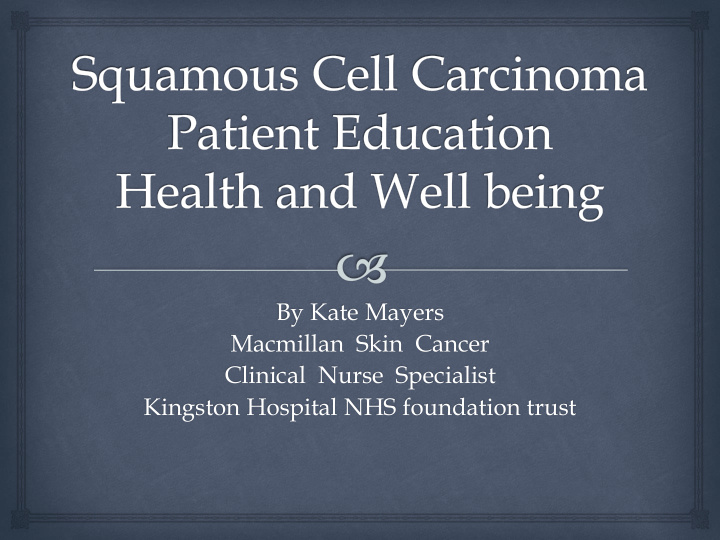



By Kate Mayers Macmillan Skin Cancer Clinical Nurse Specialist Kingston Hospital NHS foundation trust
Squamous Cell Carcinoma CLINICAL PRESENTATION “SCC usually presents as an indurated nodular keratinising or crusted tumour that may ulcerate, or it may present as an ulcer without evidence of keratinisation. Possible cutaneous SCC should be referred urgently to an appropriately trained specialist, usually in the local Dermatology Department, rapid access skin cancer clinic”. Motley, Preston & Lawrence (2009) B.A.D SCC guidelines.
Squamous Cell Carcinoma “A specialist or appropriately trained clinical nurse specialist or primary care physician may undertake regular follow-up examination for recurrent disease” Motley, Preston & Lawrence, (2009). BAD SCC guidelines. All patient’s diagnosed with SCC at Kingston Hospital are discussed at our local skin cancer MDT. A patient diagnosed with a low risk, primary SCC, can be discharged back to their GP, to continue 3 monthly follow up for oncological surveillance for approximately two years.
Low Risk SCC Tumours up Arising to 20 mm at sun exposed in diameter. sites Tumours up excluding lip to 4 mm in and ear depth and confined to dermis Well differentiated No evidence of tumour or immune Verrucuous dysfunction subtype
MDT follow up SCC diagnosis – verbal and written information. Skin examination Lymph nodes Education on self examination Advice and education on sun awareness Holistic Needs Assessment Clinical Nurse Specialist/department contact details
Examination See the patient and explain the diagnosis. Skin examination in clinic, we ask the patient to undress down to his underwear including his socks and shoes. Check the scar site to see its healed well, any sign of local recurrence. Examine all the skin, systematically checking from head to toe, front to back. A good time to reassure the patient of what is normal (benign lesions) and what to look out for.
Early signs of SCC 1: A persistent Scaly patch Often red in colour, with uneven borders Look out for a scaly patch of skin that won't heal Often these patches will crust and bleed 2: An elevated growth with central depression Growths are raised with an indentation to the centre Growths can sometimes bleed They can grow rapidly in size 3: Open sore Look out for an open sore-like wound A sore that constantly crusts and bleeds A persistent sore that won't heal over weeks 4: A wart-like growth Look out for a growth that resembles a wart A growth that crusts and sometimes bleeds A wart-like growth that won't heal or respond to treatment (http://www.skcin.org/typesOfSkinCancer/NonMelanomaSkinCancers.htm)
Checking the lymph nodes Example leaflet given to SCC patients (www.wessexcancer.org.uk)
Checking the lymph nodes (www.wessexcancer.org.uk)
Holistic Needs Assessment Effective assessment and care planning is used to identify people’s concerns and needs can lead to early interventions, diagnosis of consequences of treatment, improved communication and better equity of care. Everyone with cancer should be offered a Holistic Needs Assessment (HNA) and a care plan to set up a recovery package (health and well being, support). (Young, N. 2012.http://www.macmillan.org.uk)
HNA Providing the time to assess the patient’s holistic needs enables us to identify any immediate concerns or distress from the patient and create a care plan. Such as: Further support from a clinical nurse specialist, Counselling, Armed forces and War Veterans payments.
HNA
HNA (Young, N. 2012.http://w ww.macmillan. org.uk)
Treatment summary A treatment summary is completed following treatment, then shared with the person living with cancer and sent to their GP. A Cancer Care Review completed by the GP or Practice Nurse to discuss needs. This should happen within 6 months of the GP practice being notified that the person has a cancer diagnosis. An education and support event. Eg: Health and Wellbeing clinics, to prepare the person for transition to supported self management. Complimenting Stratified care pathways. Macmillan (2014) Sharing good practice. MAC1574.
Thank you QUESTIONS? ???
Recommend
More recommend